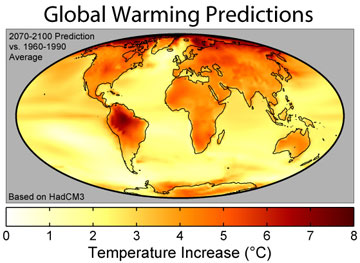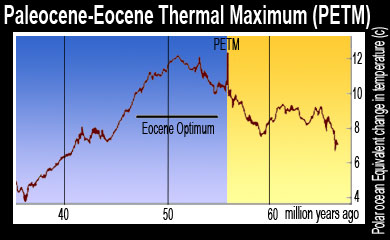Past global warming suggests massive temperature shift in our future
Past global warming suggests massive temperature shift in our future
mongabay.com
December 7, 2006
If past climate change is any indication, Earth could be in store for some significant global warming according to research published in the December 8, 2006, issue of the journal Science. The work suggests that climate change skeptics may be fighting a losing cause.
The study, led by Mark Pagani, associate professor of geology and geophysics at Yale, looked at an episode of rapid climate change that occurred some 55 million years ago. Known as the Paleocene-Eocene Thermal Maximum (PETM), the period was marked by a rapid rise in greenhouse gases that heated Earth by roughly 9° F (5° C), in less than 10,000 years. The climate warming caused widespread changes including mass extinction in the world’s oceans due to acidification and shifts of plant communities due to changes in rainfall. The era helped set the stage for the “Age of Mammals,” which included the first appearance of modern primates.
The research, based on fossil records of terrestrial plants and oceanic plankton, suggests that the world’s climate is highly sensitive to atmospheric carbon dioxide (CO2) levels, finding that a doubling of CO2 concentrations can raise global temperatures by at least 4 ºF (2.2 ºC). Current projections show that natural background atmospheric carbon dioxide levels are expected to double around mid-century due to fossil fuel combustion.
 This figure shows the predicted distribution of temperature change due to global warming from the Hadley Centre HadCM3 climate model. This figure was prepared by Robert A. Rohde from publicly available data and is available at globalwarmingart.com.
|
“We can tell that the amount of carbon released to the atmosphere and ocean was more or less the same as what is available today as coal, oil, and gas,” said Dr. Ken Caldeira, co-author of the study and a researcher at the Carnegie Institution’s Department of Global Ecology at Stanford University in California. “The carbon heated up the Earth for over 100,000 years. If the climate was as insensitive to CO2 as the climate skeptics claim, there would be no way to make the Earth so warm for so long.”
“The PETM is a stunning example of carbon dioxide-induced global warming and stands in contrast to critics who argue that the Earth’s temperature is insensitive to increases in carbon dioxide,” said Pagani. “Not only did the Earth warm by at least 9°F (5°C), but it did so during a time when Earth’s average temperature was already 9°F warmer than today.”
While the research shows a spike in atmospheric greenhouse gas levels and a corresponding leap in global temperatures, it is still unclear what caused the jump. The researchers say that the ancient carbon could have come from massive fires burning coal and other plant material or from “burps” of methane released from frozen hydrate deposits on the continental shelves.
 CO2 input during the PETM. The amount of additional atmospheric CO2 responsible for the PETM warming depends on the pre-PETM atmospheric CO2 concentration and the climate sensitivity to CO2 doubling. To determine pre-PETM atmospheric CO2 concentrations (blue line), we assumed pre-PETM global mean annual temperature 5°C warmer than during recent pre-industrial times, when atmospheric CO2 concentrations were 280 ppm. To determine PETM atmospheric CO2 concentrations (orange line), we assumed a 5°C warming during the PETM and a surface ocean 5x saturated with respect to calcite. Caption and image courtesy of Science. |
“By examining fossils and ancient sediments on the sea floor, we can see that something very unusual happened to Earth’s carbon cycle,” Caldeira explained. “At the same time the climate near the North Pole became like Miami. We can tell it didn’t take all that much carbon to make this change in climate.”
The researchers calculate that if the carbon resulted from ancient plant material, each doubling of atmospheric CO2 concentration would warm Earth by at least 4 ºF (2.2 ºC) and possibly twice this much. If methane were the source, “a doubling of atmospheric CO2 concentration would warm the Earth by over 10 ºF (5.6 ºC),” said Caldeira. “If that’s what happened, we could be in for a mighty toasty future.”
“The last time carbon was emitted to the atmosphere on the scale of what we are doing today, there were winners and losers,” Caldeira added. “There was ecological devastation, but new species rose from the ashes. Luckily for us, our ancient primate ancestors were winners. Who knows who the winners and losers will be in the next go round?”
During the PETM, ocean acidification likely caused a mass extinction of phytoplankton by reducing the availability of carbonate ions necessary for marine organisms to build calcium carbonate shells and exoskeletons. Many scientists are concerned that history could repeat itself, especially with current studies showing a steady increase in ocean acidity. In September 2005, a team of scientists writing in Nature warned that by 2100, the amount of carbonate available for marine organisms could drop by 60%. In surface ocean waters, where acidification starts before spreading to the deep sea, there may be too little carbonate for organisms to form shells as soon as 2050. The loss of these small organisms would have a disastrous impact on predators — including salmon, mackerel, herring, cod — that rely on them as a food source and could spell trouble for other species.
“Our carbon dioxide emissions are risking biological, chemical, and climate changes of a magnitude that has not been seen for more than 50 million years,” he warned. “Our work provides even more incentive to develop the clean energy sources that can provide for economic growth and development without risking the natural world that is our endowment.”
“An Ancient Carbon Mystery” was authored by Mark Pagani (Department of Geology and Geophysics, Yale University), Ken Caldeira (Department of Global Ecology, Carnegie Institution, Stanford), David Archer (Department of Geophysical Sciences, University of Chicago), James C. Zachos (University of California, Santa Cruz). The paper appears in Science: 8 DECEMBER 2006 VOL 314.
Related articles
Massive climate change rocked ecosystems, animals 55 million years ago. Continued increases in greenhouse gas concentrations in the atmosphere from the combustion of fossil fuels could trigger large-scale changes in global biodiversity and require thousands of years of recovery according to recent research on an extreme global warming episode 55 million years ago.
Climate change brought tropical forest to Wyoming. Climate change 55 million years ago caused significant changes in forest composition and the distribution of mammals according to a new study in Science. The Paleocene-Eocene Thermal Maximum, in which temperatures rose by as much as 10 degrees in a relatively short period of time, helped bolster the “Age of Mammals,” which included the first appearance of modern primates. After an initial period of increasing aridity in northern latitudes like the study site of Bighorn Basin in northwestern Wyoming, it appears that forests transitioned towards warm tropical ecosystems with closely spaced trees, ideal for the evolution of primates.
Climate change caused major disruption to past ocean currents. Massive climate change 55 million years ago caused major disruption to ocean currents according to new research by scientists at Scripps Institution of Oceanography at the University of California, San Diego. A rapid rise in global temperatures during the Palaeocene-Eocene Thermal Maximum (PETM) triggered many global shifts, including a reversal of ocean currents and large-scale changes in global biodiversity. Scientists are concerned that similar changes could result from modern-day global warming. Already, there is growing evidence to suggest a slow-down in North Atlantic currents that help keep Europe relatively warm.
Primate evolution linked to global warming says new study. New research suggests the ancient climate change fueled early primate evolution. In a paper published in the July 25 issue of the Proceedings of the National Academy of Sciences, scientists from the University of Michigan, Johns Hopkins University School of Medicine and the Royal Belgian Institute of Natural Sciences argue that rapid warming 55 million years ago at the Paleocene-Eocene thermal maximum (PETM) drove the dispersal of tarsier-like primates across the globe. Using “a carbon isotope curve recently documented on all three continents”, the researchers estimate that the evolutionary expansion event occurred within a 25,000 year period — a remarkably short amount of time. The findings undermine four previous theories to explain the geographic distribution pattern of early primates.
Past climate change caused dramatic shift in humidity, precipitation levels, temperature, and ocean water salinity. Scientists have uncovered new evidence of dramatic changes in humidity, precipitation levels, temperature, and ocean water salinity during a past episode of global warming. Analyzing plant fossils collected in the Arctic, a team of researchers led by Mark Pagani, professor of geology and geophysics at Yale University, found that water and atmospheric water vapor are a major indicator of the “greenhouse” changes.
